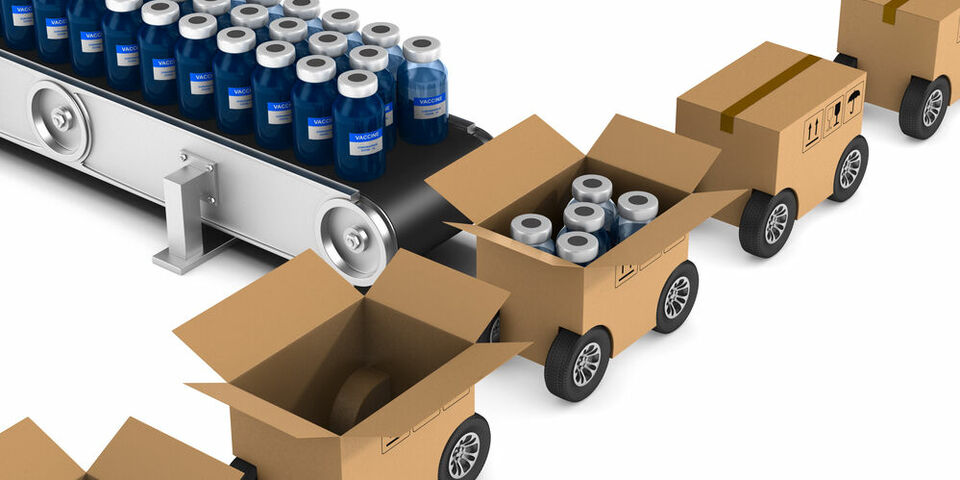Logistics model must anticipate many variables
Full Professor Jan Fransoo, an academic staff member at both Tilburg and Eindhoven, is working hard with a team of some twenty people to develop a logistics design and related models capable of anticipating the multitude of variables involved in the vaccination process. “Situations in which things could have gone better are still a regular feature of this process, but our model is intended to ensure that even when these setbacks occur, healthcare providers can still achieve the optimal result,” says Fransoo. "The starting point is simple: how do we get the available vaccines optimally into as many upper arms as possible.”
“Actually, we are running a marathon of sprints,” says Fransoo at the start of our interview, for which we are accompanied by Sjors Melman, master's student of Operations Management and Logistics at TU/e. In order to join Fransoo's team, Melman was allowed to put his internship at Philips on hold for a month. He endorses the words spoken by his former professor: “We and the team - which includes logistics specialists employed by ASML and Heineken - are working 24/7 and are talking to a great many different parties. Among them, naturally, RIVM, the Ministry of Public Health, the GGDs [municipal health services, ed.] and family physicians. We've also got researchers and students at TU/e and Tilburg University working alongside us. All of this is so that we can arrive as quickly as possible at a practicable logistics model that healthcare providers can adopt.”
In December Fransoo spoke up in the media, joining the debate about vaccination logistics. He was convinced that the development of a good logistics design would save time. Once TU/e alumnus Paul Enders, now in the position of director of Customer Supply Chain Management at ASML, had also offered his services, the pair formulated a offer of concrete help for RIVM and the GGDs. This was quickly accepted. “We even included the first steps we were already taking to build this model, so that soon got the ball rolling,” begins Fransoo. “We adopted the principle that the logistics are not subject to any limitations. This may well not be the case in other areas, for example when it comes to medical or political considerations, or the process of producing the vaccines. Our model is intended to show immediately the consequences arising whenever something changes in one of these areas. This may relate to the exact quantity of vaccines or their shelf life, or to the issue of which cohorts you want to prioritize in vaccinating.”
Uncertainties
Master's student Melman adds by way of explanation, “Where the logistics are concerned, you want to be able to react quickly to a situation. For example, the approval of a new vaccine with simpler storage, which might be the case for the vaccine produced by Janssen. Then, the whole chain needs to see the consequences of the change at once. This allows the bodies delivering the vaccination program, like RIVM and the GGDs, to adjust what they do accordingly.” After all, as Fransoo points out, the chain concerned with the vaccine itself is not the only chain that has to be considered. “There's also the chain with the vaccine-givers. Is the vaccine-giver part of the GGD or will family physicians give the shots? What is the capacity? Can it be upscaled rapidly? Are enough vaccine-givers available at the right sites? And then, of course, we have the group we need to get vaccinated. Which group or groups are these? Can they be informed in good time? Can you get them to the right sites quickly enough?”
Fransoo says this also involves taking certain uncertainties into account. “Take the number of vaccinations you can get out of a vial. For the BioNTech-Pfizer vaccine this is usually six, but it is often seven. Ideally, you want to avoid anyone making a fruitless trip to a vaccination centre, so you will plan with a margin regarding the number of vaccines you have available. That any leftover vaccines are administered to people who happen to be on site is a perfectly good solution to avoid wastage.”
User friendly
A complete first version of the model is now ready. They immediately point out that it is for the RIVM, and perhaps also the partners involved in delivery, to start working with the model, not the people who developed it. “RIVM and the GGDs have hired their own people capable of working with our models,” says Fransoo. Melman adds that the model will be designed to be as user friendly as possible; “We're giving that special attention”. Though, of course, it will still be possible to ask questions and get extra guidance, says Fransoo.
He expects the vaccination program coming soon to involve a combination of injecting people at a large number of centralized sites and giving the jab via a dense web of sites, such as the offices of family physicians. “I would like to highly recommend that overcapacity be created in, say, the number of available vaccine-givers. Don't wait until it is crystal clear is that you need more; then it'll be too late. Have them at the ready, then you can maximize the benefit of any lucky breaks that come along, as hopefully they will, and achieve optimum performance.”



Discussion